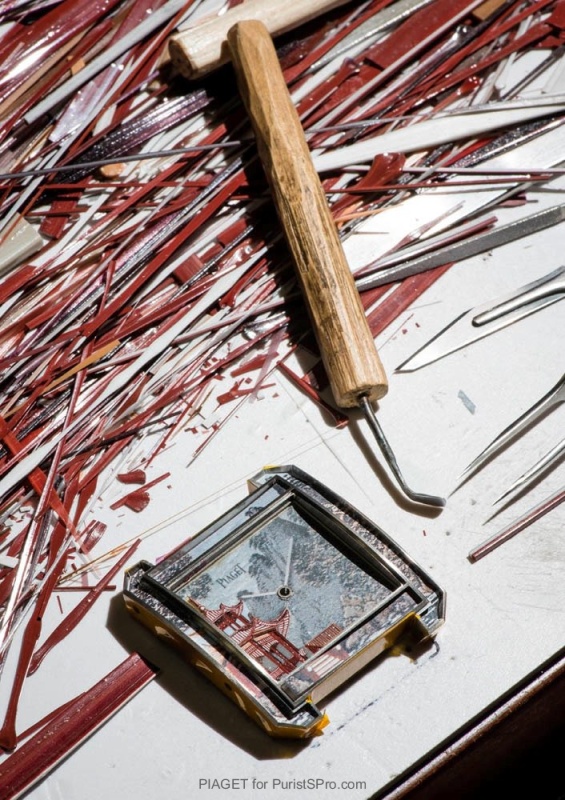
MTF
[PuristS]
13383

PIAGET Mythical Journey part 5: Micro-mosaic

Dear PuristS,
Following the launch of A Mythical Journey by Piaget in November 2013, I left this look at a most intriguing and rare technique until now:
Micro-mosaic
Micro-mosaic technique has been reported before on this Piaget forum. CLICK following URL link to read:
piaget.watchprosite.com
Mosaic in History

The oldest known mosaics are dated to the 8th century BCE in Greece. They were made of pebbles and mainly used as flooring or foot paths. The pebbles were homogeneous and were monotone with the colour range between black and white only.
Complex images were created with those simple mosaic technique. They stones were about 1 to 2 cm diameter and outlines were drawn with black pebbles. In the 4th century BCE, the colour range was extended with green and red pebbles. The colour palette was limited by the natural colours of marble and chalk.

Marble and chalk were particularly suitable for mosaics. Marble can be broken in very small pieces and provides a natural range of colours. Although the origin of mosaics is credited to the Greeks, the art-form was also used in Assyria, Egypt, Persia and other ancient civilisations.

Roman mosaics decorated walls, floors, halls, villas and public houses. Mosaic technique spread across the Mediterranean basin, to Northern Syria and Asia Minor. After the Romans, mosaics were integrated in Christian, Byzantine, Persian and Indian architecture.

The emergence of micro-mosaic occurred during the Hellenistic period, around 300 BCE, with the emergence of tesserae (tiny cubes of opaque or translucent glass paste) that allowed subtle colour shades. The Romans became experts in this art and used mosaics to adorn houses, thermal baths and fountains.
Around 400 AD, mosaics were used in Christian architecture with those at Ravenna (Italy) recognised as seminal in the history of the Art. Venetian glassmakers developed coloured glass paste. The colour possibilities of glass and the lightness of the material (smalts) made it possible to create artistic works under arches and vaults.
From the 9th century AD, mosaic became part of Byzantine culture. Churches such as St. Mark’s (Venice) and both St. Sophia’s and St. Saviour’s (Istanbul), are heritage examples of the artisanal talent.
In the 20th century AD, mosaics enjoyed renewed interest and was used by artists such as Gustav Klimt, Marc Chagall, Fernand Léger, Joan Miro, as well as by Antoni Gaudí, whose mosaics in the Guëll Park still astound us today in Barcelona.


Pieces of coloured glass to be melted to become tesserae

Melting different colours of glass : a crucial operation to obtain the perfect shade
Micro-mosaic: the sum of incredibly small parts
In 1727, the Vatican’s mosaic studio was created under Pope Benedict XIII (Pietro Francesco Orsini, later known as Friar Vincenzo Maria Orsini O.P.). At first, he called himself Benedict XIV, but changed to Benedict XIII (the previous Benedict XIII was considered an anti-pope).
Two amusing facts are that he abolished the lottery in Rome but repealed the world-wide smoking ban set by Pope Urban VIII. That is why Roman Catholics can smoke tobacco today and if you've been to France to discover their penchant for strong cigarettes, you can thank the second Pope Benedict XIII.
While the mosaic studio's main function was to make mosaics for the church, it also undertook privately commissioned work. At the end of the 18th century, Cesare Aguatti and Giacomo Raffaeli , two of the most respected and renowned artists of the time, created the art of micro-mosaics by discovering a new technique of tiny tesserae measuring less than one millimetre in diameter.
This was achieved using enamels that were fixed and brought to melting point at over 800°C. The glass paste was then cooled down and cut into tiny fragments of tesserae. This technique broadened the palette of available colours, increasing it to over 10,000 nuanced shades. This made it possible to reproduce lighting effects and a wealth of subtly graded shades. The most delicate micro-mosaic works of that era sometimes comprised up to 560 tesserae per square centimetre.

As the micro-mosaic art developed, it became an ornamental technique on cases, snuffboxes, jewellery, paintings and furniture. The main themes reproduced in micro-mosaics were the ancient monuments of Rome, religious scenes, as well as landscapes, animals and flowers.
The Manufacture Piaget enlisted the talent of a Roman artisan, a worthy descendant of those 18th century masters. Micro-mosaics had never previously been used as an ornamental technique in watchmaking.
For the Mythical Journey Collection , the colourful vista of China and India were reproduced.

Juxtaposing tiny tesserae and a polychrome effect creates a stunningly luminous effect. A light blue shade composes a radiant sky in which the clouds appear to be floating. A landscape of steep mountains is both dense and majestic. The flamboyant red pagoda is an anthem to good fortune and happiness.

The Jal Mahal palace in the Rajput and Mughal styles of architecture has that red sandstone glow. The five-storied building, out of which, four floors remain under water when the lake is full and the top floor is exposed, is the inspiration for the version used in the Mythical Journey by Piaget.
As they say at Piaget: "The infinitely small exudes an atmosphere of pure joy".

From solid to liquid: The fusion of glass

Stretching out the heated glass to create a long and thin tesserae

Heating the micro-mosaic chip to modify the glass colour and to obtain the perfect colour



Filing a micro-mosaic tessera to obtain the perfect size and shape

Grinding a micro-mosaic tessera to obtain the perfect size and shape

Controlling the size and the aesthetic of the polished micro-mosaic tesserae


The art of ultra-thin: the glass thread is stretched out to obtain an extreme thin tessera

The art of infinitely small: a bi-colour tessera used to create the micro-mosaic dial

The art of infinitely small: a tessera used to create the micro-mosaic case and dial

The art of infinitely small: one by one, the tesserae are fixed on the dial to create a truly unique piece of art

Controlling the surface of the micro-mosaic dial to ensure a perfect flatness

A drawing is used as a template to position the tesserae and to achieve a precise design



Detail of the micro-mosaic dial under creation

Comparing the original design to the micro-mosaic case and dial under creation
China


Piaget Protocole XXL Micro-Mosaic
18K white gold case with micro-mosaic, Mythical Journey logo applied under the sapphire case-back
White gold dial with micro-mosaic Asian Pagoda landscape design
Manufacture Piaget 830P, ultra-thin hand-wound mechanical movement
Functions : H, Mn, 60-hour power-reserve (approx.)
Case diameter : 42 mm x 46 mm
Bracelet : black alligator with white gold folding clasp
G0A38565 – N° 01 / 08

India


Piaget Protocole XXL Micro-Mosaic
18K pink gold case with micro-mosaic, Mythical Journey logo applied under the sapphire case-back
Pink gold dial with micro-mosaic, Indian Palace landscape design
Manufacture Piaget 830P, ultra-thin hand-wound mechanical movement
Functions : H, Mn, 60-hour power-reserve (approx.)
Case diameter: 42 mm x 46 mm
Bracelet : Black alligator with pink gold folding clasp
G0A38585 – N° 01 / 08

A Piaget Mythical Journey Begins (Overview)
piaget.watchprosite.com
PIAGET Mythical Journey part 2: Bulino Engraving
piaget.watchprosite.com
PIAGET Mythical Journey part 3: Plique-à-jour Enamel
piaget.watchprosite.com
PIAGET Mythical Journey part 4: Engraving Gold
piaget.watchprosite.com
PIAGET Mythical Journey part 5: Micro-mosaic
piaget.watchprosite.com
PIAGET Mythical Journey part 6: Precious Thread Embroidery
piaget.watchprosite.com
PIAGET Mythical Journey part 7: Miniature Enamel
piaget.watchprosite.com
PIAGET Mythical Journey part 8: Cloisonné and Champlevé Enamel
piaget.watchprosite.com
Dr M. Teillol-Foo (2014)
This message has been edited by MTF on 2014-03-14 17:11:00

PIAGET Mythical Journey part 5: Micro-mosaic

A wonderful post Melvyn!

That is just amazing

Impressive. Thanks for this superb article, Melvyn.

Piaget goes for the unusual and unique

Incredible ...

Just finished reading all parts
